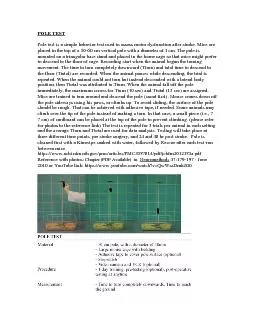

POLE TEST placed in the top of a 50 60 cm vertical pole with a diameter of 1 cm The pole is mounted on a triangular base stand and placed in the home cage so that mice might prefer to descend t ID: 836771
Download Pdf The PPT/PDF document "Pole test is a simple behavior test used..." is the property of its rightful owner. Permission is granted to download and print the materials on this web site for personal, non-commercial use only, and to display it on your personal computer provided you do not modify the materials and that you retain all copyright notices contained in the materials. By downloading content from our website, you accept the terms of this agreement.
1 POLE TEST Pole test is a simple beha
POLE TEST Pole test is a simple behavior test used to assess motor dysfunction after stroke. Mice are placed in the top of a 50 - 60 cm vertical pole with a diameter of 1 cm. The pole is mounted on a triangular base stand and placed in the home cage so that mice might prefer to descend to the floor of cage. Recording start wh en the animal began the turning movement. The time to turn completely downward (Tturn) and total time to descend to the floor (Ttotal) are recorded. When the animal pauses while descending, the trial is repeated. When the animal could not turn but instead descended with a lateral body position, then Ttotal was attributed to Tturn. When the animal fall off the pole immediately, the maximum sco res for Tturn (10 sec) and Ttotal (15 sec) are assigned. Mice are trained to turn around and descend the pole (snout first). Mouse comes down off the pole sideways using his paws, or climbs up. To avoid sliding, the surface of the pole should be rough. Tha t can be achieved with adhesive tape, if needed. Some animals may climb over the tip of the pole instead of making a turn. In that case, a small piece (i.e., 7 7 cm) of cardboard can be placed at the top of the pole to prevent climbing. (please refer for photos to the reference link) The test is repeated for 3 trials per animal in each setting and the average Tturn and Ttotal are used for data analysis. Testing will take place at three different time points, pre stroke surgery, and 24 and 48 hr post stroke . Pole is cleaned first with a Kimwipe soaked with water, followed by Rescue after each test - run between mice. https://www.ncbi.nlm.nih.gov/pmc/articles/PMC3587814/pdf/jcbfm2012185a.pdf Reference with photos: Chapter (PDF Available) in Neuromethods 47:179 - 197 · June 2010 or YouTube link: https://www.youtube.com/watch?v=QwWszDmkZ00